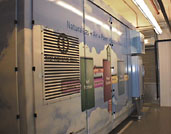That bank µ First National Bank of Omaha (FNBO), Omaha, NB, one of the largest privately owned banks in the country µ suffered a 1997 brownout that seriously disrupted its operations. Although the bank’s data center went down for just minutes, it took hours to recover and get back to normal.
In 1999, when FNBO needed to power its new 200,000-sq-ft technology center, it installed a fuel cell-based power system as the primary source of electricity. The system was designed and installed by Sure Power Corp., Danbury, CT.

A Really Big Battery
The fuel cell “uses basically the same chemistry as a battery,” explained William Cratty, president of Sure Power. It uses hydrogen and oxygen to operate; natural gas is the best carrier of these and the “most efficient fuel,” he said. The fuel cell produces electricity along with two byproducts, heat and pure water.The Sure Power system is based on commercial fuel cells from ONSI Corp., a unit of United Technologies Corp., located in South Windsor, CT. For the bank application, four ONSI 200 kW PC25 fuel cell power plants are combined using Sure Power’s proprietary technology. The system is “hot,” not standby, supplying the bank’s data center.
A generator-powered UPS (uninterruptible power supply) serves as the first backup. The electric power grid is actually the second backup.
In addition to powering the facility, the fuel cells also run a snow-melting system for the outdoor walkway.
The best grid system, noted Cratty, provides 99.9% reliability, also called three nines. The bank system’s reliability is approximately seven nines. With three nines, he said, there is “an 83% probability of a failure.” With seven nines, the bank can rest easy, with “less than 1% probability of a failure.”
The fuel cell system also is a very clean source of power. According to a study by the Center for Energy and Climate Solutions, the system cuts carbon dioxide emissions by 46% compared to a traditional UPS and its standby diesel generator.
In mid-1999, the fuel cells demonstrated their worth. There was a series of brownouts in the bank’s area, but the data center experienced no loss of power.
Sure Power also has done fuel cell installations at military bases for ONSI, and the company is looking at other data center applications.

Longest Running System
Siemens Westinghouse Power Corp., Orlando, FL, recently announced that what is believed to be the world’s longest operating high-temperature fuel cell power system, the 100 kW solid oxide fuel cell (SOFC) cogeneration system located in Westervoort, the Netherlands, successfully completed its contracted operating period of two years.The SOFC system was supplied to EDB/ELSAM, a consortium of Dutch and Danish utilities, by Siemens Westinghouse in late 1997. Early in 2001, the system will be moved to a new site for continued operation.
At the time the system was shut down, “it had accumulated 16,612 hours of operation since its original startup in December 1997. After restart of the system with a rebuilt fuel cell stack in March 1999, the system operated for nearly 12,600 cumulative hours without any performance degradation,” said Herman Verbeek, project manager for EnergieNed, the Federation of Energy Companies in the Netherlands, which manages the project for EDB/ELSAM.
“We were very pleased with the performance of the system and it accomplished all the objectives we had set for it.”
The unit was operating with an electrical efficiency of over 46%. The emissions from the system were low, with NOX, SOX, CO, and VHCs all measured below 1 ppmv.
Siemens Westinghouse plans to commercialize SOFC cogeneration systems in the 250- to 1,000-kW range with first commercial deliveries in 2004. The company is developing the technology under a cooperative agreement with the Department of Energy (DOE), through its National Energy Technology Laboratory.
New Supplier of Aftermarket Refrigeration Compressor Parts
HOUSTON, TX — Refrigeration Compressor Parts, Inc. (RCP), a new source for aftermarket refrigeration compressor parts based here, is building its inventory for a March 1 startup. The company will carry replacement parts for major brands of commercial and light industrial refrigeration compressors.RCP is headed by Chet Emmons, formerly with Bradley Hermetics in Corpus Christi, TX. Emmons has worked in the industry for over 17 years.
“Our goal is to maintain inventory levels of high-quality replacement parts so that we can provide same-day shipping and a high level of customer service,” said Emmons. As an incentive to give the new company a try, a $50 credit is being offered on the first order for each new account.
For more information, call the company at 800-831-2624 or 713-224-1331; or visit www.rcpusa.com (website).
Publication date: 01/29/2001


Report Abusive Comment